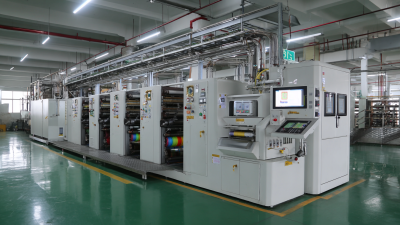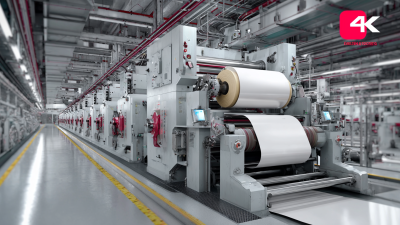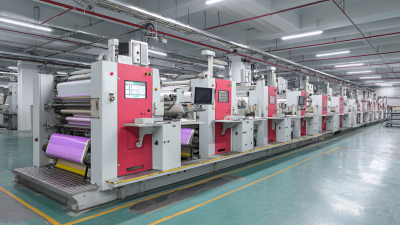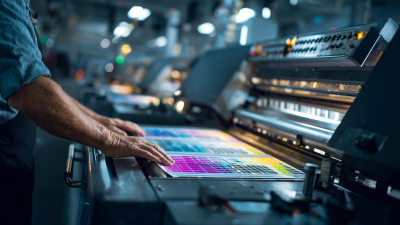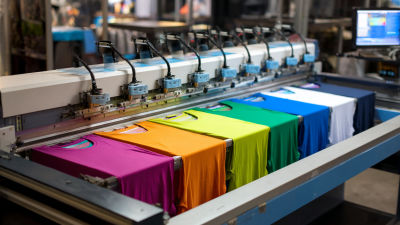In today's competitive marketplace, effective branding is crucial for businesses aiming to establish a strong identity and expand their market reach. One of the most significant advancements that have transformed the branding landscape is the introduction of the Trademark Printing Machine. These innovative devices enable companies to produce high-quality, customized labels and branding materials that not only enhance product visibility but also reinforce brand recognition. As businesses strive to distinguish themselves in an overcrowded environment, the ability to print unique trademarks directly onto products can provide a substantial competitive edge.

The integration of Trademark Printing Machines into production processes allows for greater flexibility and creativity, facilitating the quick adaptation of branding strategies to meet consumer demands. Furthermore, these machines enhance efficiency and cost-effectiveness, enabling brands to scale their operations without compromising on quality or originality. This article explores the top five ways in which Trademark Printing Machines are revolutionizing branding efforts, highlighting their impact on product identity and market penetration. As we delve into these transformative technologies, it becomes clear that the future of branding relies heavily on the capabilities offered by Trademark Printing Machines, making them an indispensable tool for modern enterprises.
Digital printing has dramatically transformed the way brands communicate their identity and engage with consumers. According to Smithers Pira, the global digital printing market is expected to grow from $29.87 billion in 2020 to over $41.09 billion by 2024, highlighting the increasing reliance on digital solutions for branding needs. This evolution allows businesses to personalize products at scale, enabling them to tailor their messaging and visual identity to meet the diverse preferences of consumers. The efficiency of digital printing not only reduces production time but also allows for shorter print runs without the significant cost increases traditionally associated with small batch printing.
Moreover, the versatility of digital printing machines enhances branding strategies by enabling businesses to easily adapt their designs and labels to align with marketing campaigns or respond swiftly to changing market trends. A report from Technavio indicates that digital printing offers a 50% reduction in lead times compared to conventional methods. This agility means that companies can introduce new products or promotions more rapidly, strengthening their market presence and improving customer loyalty. By leveraging digital printing technology, brands can not only enhance their identity but also improve overall market reach in an increasingly competitive landscape.
The digital printing machine market is poised for substantial growth, with projections indicating that its value will reach approximately $318.594 million by 2025 and further expand to $44.88503 billion by 2033, which reflects a compound annual growth rate (CAGR) of 4.38%. This growth underscores a shift in how brands are leveraging technology to enhance their product identity and extend their market reach. Notably, the Chinese market alone anticipates a year-on-year increase of 9.5% in 2024, demonstrating robust demand for digital industrial printing solutions.
Tips for businesses looking to capitalize on this trend include investing in high-quality digital printing technologies that allow for versatile branding possibilities. Brands should also focus on integrating sustainable practices in their printing processes to appeal to environmentally conscious consumers. Additionally, keeping abreast of technological advancements in printing machines can provide a competitive edge and optimize production efficiency. This proactive approach will not only strengthen product identity but also significantly enhance market visibility.
The modern printing industry is undergoing a transformation driven by consumer demand for customization and personalization. As brands seek to differentiate themselves in a saturated market, innovative printing technologies are offering unprecedented customization capabilities. Custom printing allows businesses to create unique packaging, labels, and promotional materials that resonate with individual consumer preferences, thereby enhancing product identity and fostering deeper customer connections. This trend is evident in sectors ranging from apparel to food and beverage, where tailored designs are not just a luxury but a pivotal strategy for brand loyalty.
As we approach 2026, several key trends are emerging in the printing landscape. The rise of on-demand printing is allowing companies to meet consumer demands swiftly while minimizing waste. Additionally, advancements in sustainability are prompting brands to invest in eco-friendly materials and processes, making responsible production central to their identity. Furthermore, the integration of technology, such as augmented reality in printed materials, is bridging the gap between physical and digital experiences, allowing for more engaging and interactive product presentations. These developments are setting the stage for a dynamic and responsive printing environment that prioritizes customization and brand identity.
Consumer recognition is a critical factor in determining the success of a brand, and recent statistics underscore its importance. According to a 2022 survey by Nielsen, brands with strong visual identities are 13% more likely to be recognized by consumers. This recognition not only drives sales but also builds customer loyalty. When products are easily identifiable, consumers are more likely to feel a sense of trust and familiarity, which is essential in today’s competitive marketplace.
One effective way to enhance brand imaging is through the use of advanced trademark printing machines. These machines allow brands to create unique and high-quality labels that reflect their identity. In fact, a study by the Journal of Brand Management found that 70% of consumers said they could easily identify a product based solely on its labeling. This reinforces the idea that investing in high-quality branding tools directly correlates with improved market reach and consumer recognition.
Tips:
1. Focus on consistency in branding across all products to reinforce consumer recognition.
2. Utilize bold and clear typography on labels, as studies show that readability significantly impacts brand recall.
3. Experiment with innovative materials and finishes for your trademark printing to make your product stand out on shelves.
In the ever-evolving landscape of branding, businesses face a critical choice between traditional and digital printing methods. A recent report highlights that digital printing is projected to replace conventional methods in the next five years, primarily due to its ability to provide cost-effective and high-quality solutions.
For instance, digital printing reduces setup costs and allows for short-run printing, which is ideal for modern marketing strategies that demand rapid production and customization. In contrast, traditional methods often involve higher upfront investments and longer turnaround times, making them less suitable for dynamic market demands.
Moreover, the advantages of digital printing extend beyond cost-effectiveness. The technology facilitates real-time updates and modifications, enabling brands to respond swiftly to market trends and consumer preferences. This adaptability not only enhances product identity but also broadens market reach.
With digital methods, companies can produce unique labeling and packaging that resonate with target audiences, ultimately fostering stronger brand loyalty. As the branding landscape continues to shift, embracing digital printing solutions will be essential for companies aiming to maintain competitiveness and relevance in the market.
